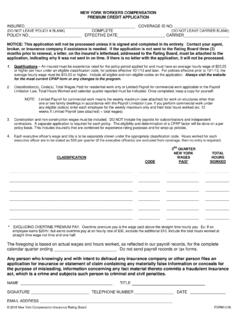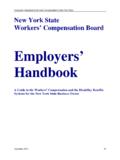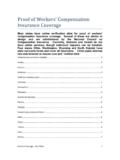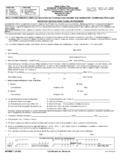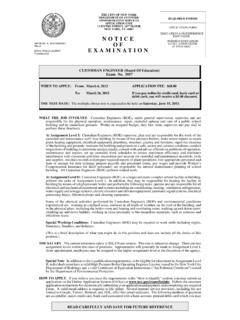Transcription of Standard & Poor’s Corporate Governance Scores …
1 Standard & Poor s Corporate Governance Scores and Evaluations Criteria, Methodology And Definitions January, 2004 Standard & Poor s Governance Services 2 Copyright 2004 By the McGraw-Hill Companies Inc. 55 Water Street New York, NY 10041 All rights reserved. May not be reproduced in whole or in part by any means without the written consent of Standard & Poor s. Standard & Poor s Corporate Governance Scores are not credit ratings or recommendations to purchase, sell or hold any interest in any company as they do not comment on market price or suitability for a particular investor. Corporate Governance Scores are based on current information provided to Standard & Poor s by a company or other sources Standard & Poor s considers reliable.
2 Standard & Poor s does not perform an audit or independently verify information in connection with any Corporate Governance score and may rely on unaudited information and other non-public information. Corporate Governance Scores may be changed, suspended or withdrawn as a result of changes in, or unavailability of, such information, or based on other Confidential information available to Standard & Poor s Governance Services may be made available to Standard & Poor s Rating Services. 3 CONTENTS _____ 1 Why Measure Corporate Governance ? 2 Corporate Governance , the Economy and Financial Markets 3 Measuring Corporate Governance Practices Overview Definitions Corporate Governance Scoring Framework Relationship to Credit Ratings 4 Company Corporate Governance Scoring Criteria and Process Ownership Structure and External Influences Transparency of Ownership Structure Concentration and Influence of Ownership and External Stakeholders Shareholder Rights and Stakeholder Relations Shareholder Meeting and Voting Procedures Ownership Rights and Takeover Defenses Stakeholder Relations Transparency, Disclosure and Audit Content of Public Disclosure Timing of, and Access to.
3 Public Disclosure The Audit Process Board Structure and Effectiveness Board Structure and Independence Role and Effectiveness of the Board Director and Senior Executive Compensation Corporate Governance Scoring Committee Surveillance Governance Watch Company Report Format 5 Country Governance Review Market Infrastructure Legal Infrastructure Regulatory Infrastructure Informational Infrastructure 6 How the Company Scores and Country Analysis Fit Together 7 Applications of Corporate Governance Scores and Benchmarks 8 Methodology Development Appendix - Information Required Prior to a Corporate Governance Scoring Meeting - Typical Interviewees for the Scoring Process - Scoring Definitions 4 1.
4 WHY MEASURE Corporate Governance ? Awareness of Corporate Governance and its role in the global economy has grown steadily in recent years. In developed markets, particularly where there exists an active market for Corporate control, Governance concerns are increasingly articulated by shareholder value activists, and companies Governance practices are regularly scrutinized in the public domain. The recent Corporate failures of prominent companies in the US, and Governance related problems at visible European companies all contribute to greater attention to Corporate Governance as a stand alone risk factor in developed markets.
5 In the emerging markets, the financial crises in Russia and East Asia in the late 1990s also revealed great gaps in Corporate Governance practices that many economists attribute to helping to bring about these crises. Stock exchanges and regulators around the world are increasingly looking to set standards or codes of best practice for Corporate Governance . Moreover, investors are beginning to review more systematically a company s Corporate Governance practices as part of the investment decision- making process. Increasingly, the debate on Corporate Governance extends beyond a company s own shareholders to include other stakeholders such as creditors, employees, customers, the environment and the local community.
6 In the context of this growing interest in Corporate Governance , there is a role for global benchmarks to help a company s shareholders, managers, directors or other stakeholders objectively assess and compare Corporate Governance practices from one firm to another and from one country to another. The concept of Corporate Governance rating, or scoring, is a way to address this gap, and several firms around the world have either launched Governance scoring activities or are actively exploring entry into this area. Standard & Poor s began to develop a methodology to benchmark Corporate Governance in early 1998.
7 Following a pilot project to test this methodology, Standard & Poor s formed a dedicated unit, Governance Services, and launched a Corporate Governance scoring service in 2000. In 2004, the unit became a part of the Corporate & Government Services group of Credit Market Services, the division within Standard & Poor s that provides credit ratings to public and private issuers of debt. This criteria presents the concept of Corporate Governance scoring at both the individual company and at the country level. While there are potentially many approaches to assessing Corporate Governance , this approach takes a financial perspective, namely the perspective of financial stakeholders-- both shareholders and creditors.
8 On that basis, and for purposes of this discussion, Corporate Governance can be defined as the interaction of managers, directors and shareholders to direct and control the company, and to ensure that all financial stakeholders receive their fair share of a company s earnings and assets. Even with this financial focus, the practice of Corporate Governance scoring is a challenging endeavor, and must be approached with care. Unlike other forms of financial analysis where quantitative measures can provide some hard benchmarks to guide more qualitative aspects of analysis, the assessment of Corporate Governance is largely a qualitative exercise.
9 This chapter will address how the practice of Corporate Governance at the company level and how Corporate Governance is influenced at the country level can be broken down into subcomponents for detailed analysis and benchmarking. The great challenge of establishing a single global benchmark that can legislate meaningfully for the differing cultures of Corporate Governance around the world must not be underestimated. As these criteria will discuss, overarching principles of fairness, transparency, accountability and responsibility must guide the interpretation of different Governance structures and systems at the Corporate level.
10 As with many forms of analysis, a global perspective must mesh with local understanding. 5 While other non-financial stakeholders may find value in this approach to Corporate Governance benchmarking, this methodology does not directly address broader stakeholder issues unless they in some way affect the economic performance, the market value, or the financial strength of the company. The main beneficiaries of this approach to Corporate Governance benchmarking are as follows: --Shareholders (minority and majority) --Creditors --Management --Directors --Regulators/Exchanges --Directors and Officers insurance underwriters --Policymakers --Financial Intermediaries and Advisors --Analysts --Academics For these constituencies, Corporate Governance Scores can serve as a new tool with varying potential applications, including investment screening, highlighting areas for individual firm improvement, guiding regulation and policy, and helping to price and place issues of new capital.
